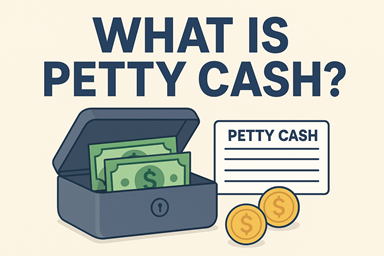Petty cash can be described as a small sum of money that a company holds in the reserve to meet small day-to-day expenses. Petty cash is used instead of writing a check or putting a small payment on a company credit card as it is a fast and easy method of dealing with immediate requirements. Common applications are purchasing office supplies, postage fees or employee reimbursements. Although the sum of money in petty cash is normally small, it is significant in the normal running of business.
Petty Cash Meaning
Petty cash is a word that was coined by the word petty meaning small or minor. It is simply a fund that is used on small, miscellaneous expenses that were not practical to be paid using formal accounting procedures. In the case of an instance where an employee requires to buy a pen or ship a package, petty cash can be used instead of undergoing long procedures in the approval departments.
Is Petty Cash Asset or an Expense?
The current cash asset is regarded as petty cash as it contains liquid cash that is stored at the company. It is reflected in the balance sheet in the Cash and Cash Equivalents. But in case of expenditure of petty cash, the expenditure is classified according to its intended use like office supplies, travel, or miscellaneous expenditures. This difference would guarantee proper financial reporting.
Purpose of Petty Cash
The primary purpose of a petty cash system is to have fast availability of money to conduct minor transactions. These may be used as follows:
Purchasing office supplies or stationery.
Making some small repairs or maintenance payments.
Paying up of delivery fees, taxi or parking costs.
Paying employees minor out of pocket costs.
With petty cash at hand, businesses will not have to experience undue delays and its operations continue on daily basis.
Custodian and Petty Cash Voucher.
In a bid to be accountable, firms normally have a petty cashier or custodian that operates the fund. Whenever cash is being withdrawn, this is done by filling a petty cash voucher, which must indicate the date, amount, purpose, and the recipient of the cash. This provides transparency and good monitoring on all the petty cash expenditure.
Establishing a Petty Cash System.
Businesses use the following steps to establish petty cash:
Establish the amount- Determine the amount of money that should be held which is normally in the range of 100-500 dollars depending on the requirements of the company.
Appoint a custodian – appoint an employee who is trusted to manage the fund.
Record transactions- Each petty cash payment should be used with vouchers and receipts.
Reserve the fund -When the balance is too small, it is replenished by the main bank account of the company.
Benefits of Petty Cash
Keeping a petty cash fund will have a number of advantages:
Conserves time when making small purchases.
Saves paperwork in case of small transactions.
Enhances effectiveness in the daily business.
Brings in flexibility in management of urgent expenses.
Conclusion
The petty cash is a small financial instrument, but it makes a great contribution to efficiency and convenience of the business operations. Through a well-managed petty cash, the companies are able to meet the minor expenses without any delays and at the same time maintain proper financial records. Correct records and monitoring can assist the businesses in keeping up with the transparency, which petty cash is a beneficial asset to daily operation.

